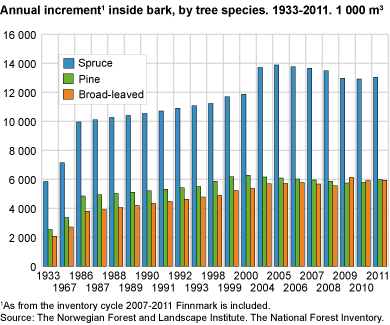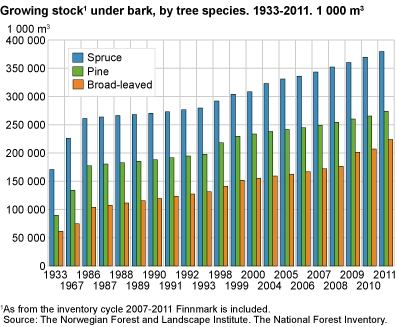Content
Published:
This is an archived release.
Twice as much wood as in the 1960s
According to calculations from the National Forest Inventory, the total growing stock in Norwegian forests is now 878 million cubic metres. This is twice as much as in the 1960s.
Out of the total growing stock, 788 million cubic metres stand on the productive forest area. The annual increment in productive forest amounted to 23.1 million cubic metres, while the annual increment in total was almost 24.9 million cubic metres. During the last five years, the annual increment has been reduced by 1 million cubic metres.
Spruce most common
Spruce is the most common species of tree with 43 per cent of growing stock, followed by pine with 31 per cent and broad-leaved with 26 per cent. During the last five years, the spruce stock has increased by 13 per cent, pine by 12 per cent and the broad-leaved by 34 per cent. In total, the growing stock has doubled since the 1960s, even though some of the growth is caused by including areas above the coniferous forest line and the county of Finnmark.
Increased productive forest area
The productive forest area, which from the inventory cycle 2007-2011 also includes Finnmark, is estimated at 83 399 square kilometres. Protected or other closed-off areas of productive forest are not included. The total area of unproductive forest and other forest land was 44 865 square kilometres.
Tables:
- Table 1 Growing stock inside bark and annual increment inside bark. The whole country. 1933-2011. 1 000 m
- Table 2 Total area, by type of vegetation and surveyed regions. 2007-2011. km
- Table 3 Productive forest area, by development class. 1 000 hectares and per cent
- Table 4 Growing stock under bark, by type of land, tree species and surveyed regions. 2007-2011. 1 000 m
- Table 5 Annual increment under bark, by type of land, tree species and surveyed regions. 2007-2011. 1 000 m
- Table 6 Registered incidence of different habitats in productive forest, by region. 2007-2011. Hectares and per cent
Contact
-
Trond Amund Steinset
E-mail: trond.amund.steinset@ssb.no
tel.: (+47) 40 81 13 73


